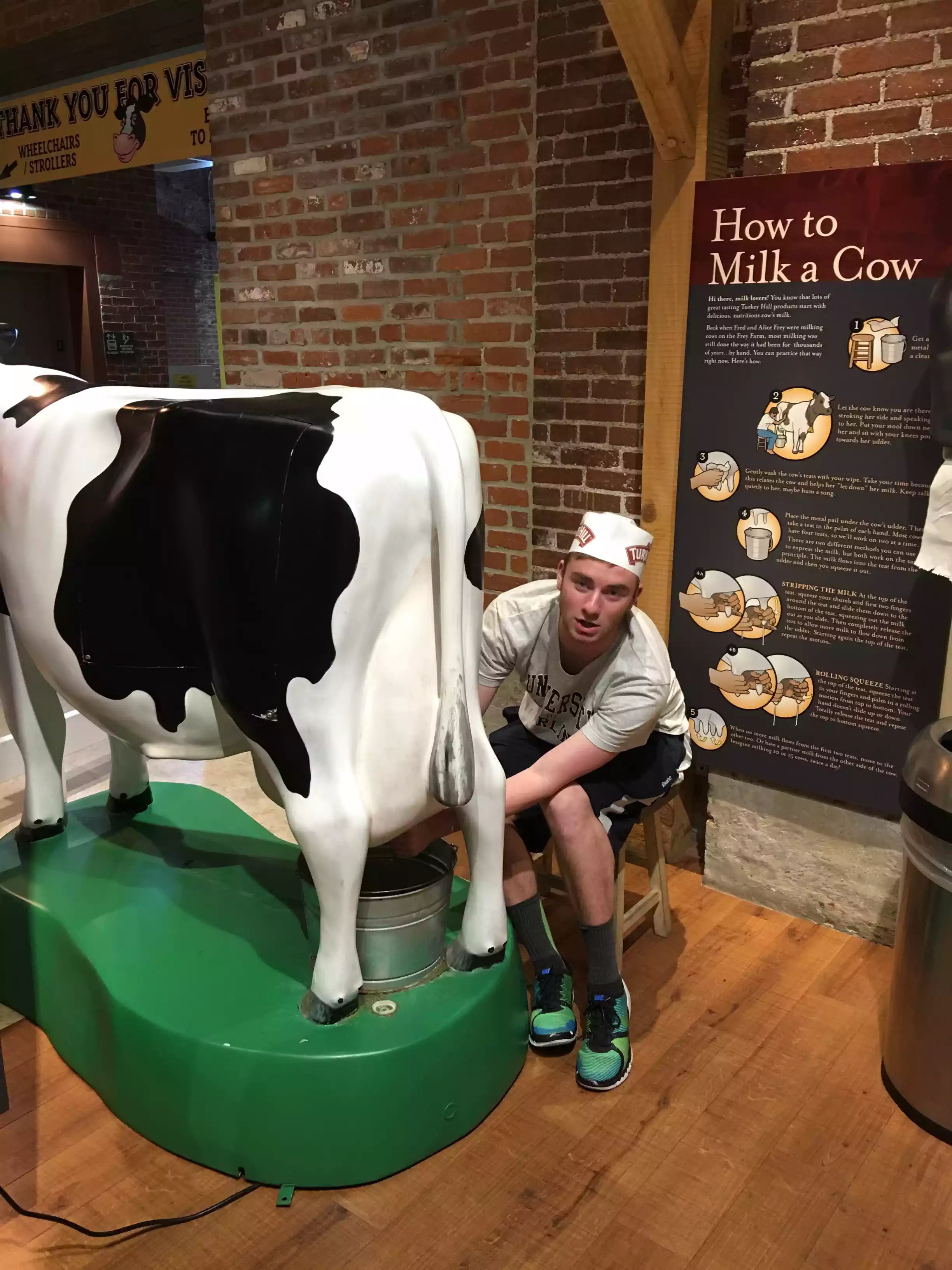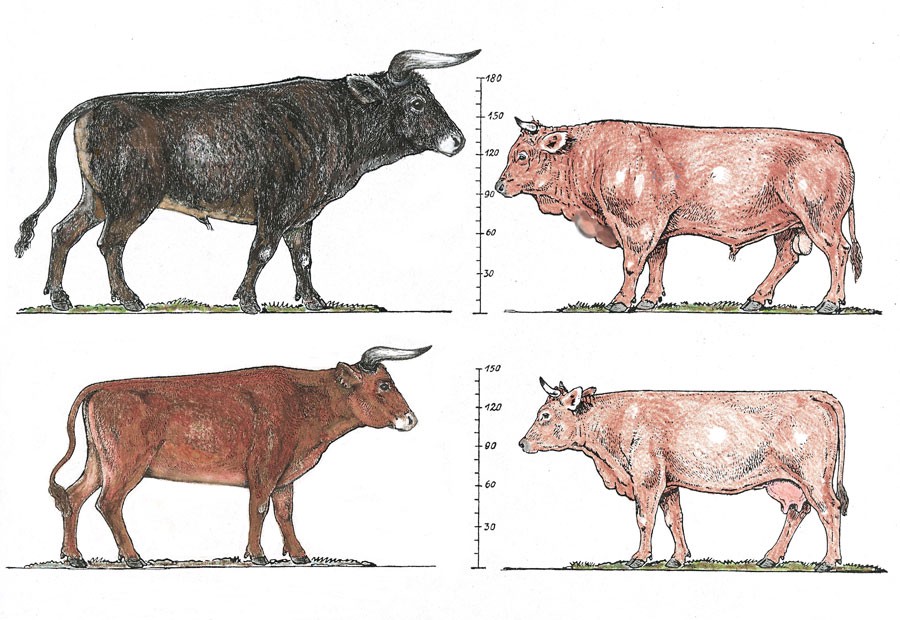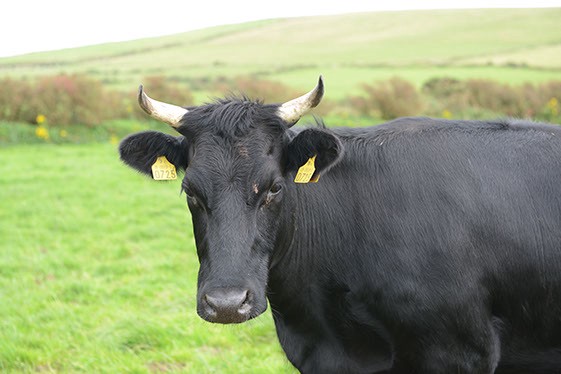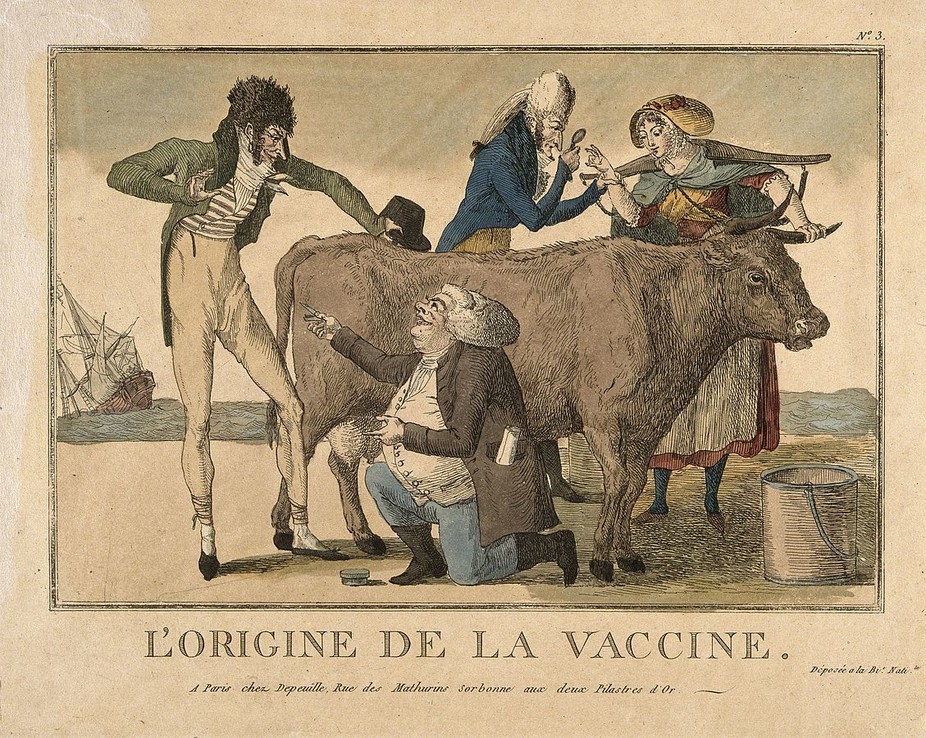Say that 5 times fast.
I remember visiting the Turkey Hill Experience with my roommate in Pennsylvania. My roommate crouched under a fake cow, fiddling with its udders like an imbecile. ?When she says she likes country boys,? he said. To my chagrin, this episode stuck in my head for quite some time, and ever since, I?ve wondered about the first cow milker. This is a question that has been floating around on the Internet for awhile: why did the first man to milk a cow milk it in the first place? Some would say desperation or starvation, others might say perversion. In any case, this ?common sense,? explanation is not enough. By just assuming, we?ll never have a deeper understanding of the history of part of our culture ? that is, the history of milk and how it contributed to the development of the human body, the food industry, and even smallpox. I, myself, never considered the importance of milk, besides the fact that I need it for my tea and oatmeal in the morning. We take it for granted ? some people might not realize that milking cows brought about the domestication of cattle, the development of butter and cheese, and actually shaped the food industry we know and need today; yet, we don?t really know how cow-milking initially came to become part of modern culture. One could argue that this says a lot about our society, appreciating the results but not understanding the origin. Regardless, in the pursuit of such knowledge, this begs the question: why did the first cow milker decide to milk a cow, and how did milk persist to become the global commodity it is today?
 ?When she says she likes country boys.? -Shane Kalette, roommate, resident idiot.Listen to a dairy cow, if you really want to.
?When she says she likes country boys.? -Shane Kalette, roommate, resident idiot.Listen to a dairy cow, if you really want to.
Across the millions of forums spanning the web, a surprising amount of people discuss the origins of cow?s milk. The people in question are of varying ages, and they don?t have to have a vested interest in farming. Despite their curiosity, it came to my attention that they seem to be asking the wrong questions. There are massive gaps in commentary. To understand why, how, and when cows were domesticated, we must first understand where they came from. The wild ancestors of modern cows were called Aurochs. They once ranged throughout Asia, Europe and North Africa. According to ProCon?s Historical Timeline of Cow?s Milk, Aurochs were first domesticated 8,000 to 10,000 years ago. They evolved into two types of domestic cattle, bos indicus and bos taurus.
 Aurochs (left) vs the modern bovine (right)
Aurochs (left) vs the modern bovine (right)
Bos indicus is a breed of cattle that are more suited to tropical climates, while bos taurus are adapted to temperate environments. As a result, scientists have differing opinions on the spread of said domesticated cattle. Some believe Aurochs spread throughout Eurasia, and others believe that other Aurochs were domesticated separately in the Pakistan/India area. It makes sense, then, that Aurochs adapted to temperate and tropical climates, if they were domesticated in separate countries. Be that as it may, according to degraded fats found on European pot shards ascribed to the Neolithic Era (according to the ASPRO chronology, the Neolithic Era dates from 10,200 B.C. to 4500/2000 B.C.), English and Northern European farmers may have been the first or among the first to begin drinking cow?s milk. It?s possible that the first Aurochs were milked 8,000 to 10,000 years ago in two different parts of the world, since domestication is attributed to cow-milking, but it?s likely that European farmers were the first. As such, humans have been drinking cow?s milk for about 6,000?8,000 years. (See: ?Early Brits Were Original Cheeseheads,? dsc.discovery.com, Oct. 10, 2006.)
Even if Neolithic farmers were engaging in the consumption of cow?s milk, scientists say that early Europeans ? and other early milk-drinkers ? were lactose intolerant. It was only later that humans slowly achieved the ability to digest milk through a genetic mutation, ?lactase persistence.? This is the continued activity of the enzyme lactase throughout adulthood. The mutation occurred about 7,500 years ago, between 5000?4000 B.C. It?s likely that before the genetic mutation ? even as the farmers depended on milk for nourishment ? if they were drinking it, they were still suffering through lactose intolerance. It took years for the genetic mutation to occur, but I daresay intolerance is better than starving.
Even though we have all of this information, we still don?t understand why. Why did they drink it in the first place? It?s a safe assumption to say that the first milker (as I?ve affectionately come to refer to him as) didn?t suddenly decide to conduct sexual experiments with his farm animals. Likewise, he probably didn?t wake up and say, ?Hey, today I?m going to further Western civilization with a revolutionary discovery.? Rather, it?s likely the the man in question ? or men, it could?ve been any number of people ? were starving. They could?ve witnessed the cow?s calf suckling on its mother?s teat for nourishment, and went to try it themselves. While it is still speculation, the most likely hypothesis is that desperation and starvation drove early farmers to cow?s milk; this is the most widely accepted theory in the historical farming community, although the exact person and reason may be debated. How then, despite the initial intolerance, did milk grow to become a major part of farming and modern culture?
The production of milk provided a constant source of nourishment for early farmers, and it grew into other products. Milk is credited with the development of the modern food industry because of its presence in much of today?s culture, but also because of the creation of cheese and butter. Neither would exist if one brave farmer hadn?t tempted fate on what I assume was one of many particularly dismal mornings.
In what is now Kujawy, Poland, archaeologists found ancient strainers with evidence of milk fats molecules. This dates cheese-making to approximately 5,500 B.C. Consequently, the earliest record of cheese joins the archaeological record earlier than butter, which doesn?t appear until approximately 2,500 B.C., and may have even been named after cheese. The word ?butter,? is believed to be derived from the Greek term, ?bou-tyron,? which literally translates to ?cow cheese.? The first appearance of butter in recorded history was on an ancient Sumerian tablet depicting dairy production in its earliest forms, including cow-milking and butter-making.
 ?5000 Years of Human Culture and Civilization.?
?5000 Years of Human Culture and Civilization.?
After cheese and butter became staples in the average kitchen, milk and other dairy products still progressed to become huge commodities; milk has been described as the ?virtual queen of the supermarket,? as told by author Deborah Valenze in her book, Milk: A Local and Global History. Contrary to its blurry origins, milk actually has a fairly clear history within the last few hundred years. Why does this history matter? Well, don?t you care how your food has been produced? Food studies have become more popular recently, paving the way for the modernized food industry and other commodities we altered to create a so-called ?sterile commercial identity?? But that?s another issue. Even though the food industry we know today was formed slowly, it stretches hundreds of years into the past, branching out as the first cattle arrived at the Plymouth colony in 1623.
When the pilgrims sailed to Plymouth, they did not bring any cattle aboard the Mayflower. The pilgrims? cattle didn?t arrive in the ?New World,? until the ship Anne arrived in 1623, and the ship Jacob in 1624. The cattle described on the ships weren?t diminutive, but nor were they massive. They were described as having black hides, so it is speculated that the cows were in fact Kerry cattle, a now rare and historic breed.
 Kerry cattle
Kerry cattle
As the Americas expanded, milk played a vital role in the survival of its people. During the food shortage of 1772, Roman Catholic Spanish priest Junpero Serra said, ??milk from the cows and some vegetables from the garden have been [our] chief subsistence.? Afterward, the benefits of milk drinking only spread ? milk continued to evolve with society in earnest, becoming a huge part of production.
The history of cows ? and by extension, milk ? stretches beyond the food industry, and they weren?t used just to supply sustenance. In the 18th century, common folk Europeans began to realize that milkmaids ? who milked cows on a daily basis ? were seemingly immune to smallpox. Upon further investigation, the public realized that these dairymaids had contracted cowpox due to their near-constant exposure to the cows? udders, resulting in an unintentional immunity to smallpox. Cowpox is a similar virus to smallpox, albeit much milder as the bovine equivalent. This knowledge and the spreading plague led English physician Edward Jenner to develop a vaccine based on the milkmaids? immunity. Jenner recovered a sample of cowpox from the women and used it to deliberately infect a young boy named James Phipps. Afterward, Jenner exposed Phipps to smallpox ? and James Phipps did not contract the disease. After experimenting with other willing subjects, Jenner officially concluded that exposure to cowpox resulted in smallpox immunity. He later marketed the cowpox vaccination, and in the United States, the vaccination was introduced in the early 1800s.
 The origins of the vaccine
The origins of the vaccine
After cowpox was used as an indirect vaccination against smallpox, the demand for milk grew exponentially between 1840 and the 1920s. In the 19th century, alcohol distillery companies similarly grew, resulting in excess swill, which are a spent-grain byproduct of alcohol production. The distilleries began opening dairies to feed their cows with excess waste swill. The swill was low in nutrients and otherwise poor feed for the cows, which resulted in poor milk quality and sickness in the cows and whoever drank their milk ? that?s right, including us humans.
The germ-infested milk that was rampantly flowing through the United States was leading to foodborne illness and other infections. However, this process was not understood by the general public, and French chemist and biologist Louis Pasteur helped to prove that such diseases were the result of germs through his ?germ theory.? He has henceforth been considered to be a founding father of microbiology. Pasteur?s research uncovered the harmful microbes in milk that caused sickness, so he created a process that would later be dubbed, ?pasteurization.? This process rapidly heats and cools the milk to kill residing organisms.
Even after Louis Pasteur discovered the helpful qualities of pasteurizing otherwise raw liquids, it took until about 1895 for the public to recognize commercial pasteurization. For years, other foodborne illnesses were attributed to raw milk, such as the New York Typhoid epidemic of 1913. It wasn?t until 1917 that the pasteurization process was made mandatory, but machines were built to make the process easier, and the spread of milk continued. Before the patent on glass milk bottles was established in 1884 (ironically, before commercial pasteurization), milkmen would carry their milk in buckets. To provide cleaner milk for communities, the glass bottle milkman is born, remaining a stereotype in white-picket-fence American life until the 1950s, when milk cartons began to appear in modern markets.
 ?I saw the guvnor?s photo in the paper this mornin?,? (the old-fashioned metal bucket milkman).
?I saw the guvnor?s photo in the paper this mornin?,? (the old-fashioned metal bucket milkman).
Even when the popularity of milk was at its peak, remember when I told you that cows and milk weren?t just used for sustenance? Skim milk specifically has an interesting tidbit of history. Before skim milk became a huge weight-loss attraction, nobody really drank it. As skim milk was a result of the butter-making process, it was often discarded; in the 1920s, it was found so useless that companies often dumped it into rivers, along with their excess whey and buttermilk. Specifically, Wisconsin dairy plants were guilty of dumping approximately 40,000 pounds ? 40,000 pounds! ? of raw dairy products into state waterways. Because of this influx of milk pollution (is that a thing?), the rivers would occasionally flood into the countryside. Plus, bluntly speaking, the surrounding area just smelled absolutely awful. To avoid further pollution and the problems that came with it, the companies were forced to either dispose of their excess milks some other way, or create a new use for skim milk.
Skim milk didn?t seem to have much value until the 1930s. There?s a byproduct of skim milk called casein. Circa 1930, while experimenting with skim milk, Italian and American scientists found that they could extract the then-unknown casein from it, transform it into a fiber, and use it as a material for countless projects. The experimentation was, in part, to further the production of wool and cotton ? a wartime supply. Later, skim milk was also used in World War II as a packaged dry product for the Allies, but the casein plastics proved to be much more beneficial to the war effort. The official process of creating the casein polymer is as follows:
?When milk is heated and combined with an acid, such as vinegar, the casein molecules unfold and reorganize into a long chain. Each casein molecule is a monomer and the chain of casein monomers is a polymer. The polymer can be scooped up and molded, which is why plastic made from milk is called casein plastic.? (Teisha Rowland for ?Science Buddies Guide?.)
Through this, casein became a plastic applicable almost anywhere. Some people even believed that casein might be the next big fashion statement, but so-called ?creamy clothing? began to go out of style almost as quickly as it was discovered. In recent years, a more modern German fashion designer named Anke Domaske has furthered milk fashion, inventing a new fiber called QMilch. If you?re not into cotton clothing, maybe this is the material for you! Got fiber?
 The milk sorceress herself, Anke Domaske
The milk sorceress herself, Anke Domaske
Creamy milk clothing aside, it proves the point that the progression of milk from the pasture to the supermarket was a slow and steady climb. It began as a drink, was manipulated to become cheese and butter, and moved on to become a global commodity. It stretched from early farmer?s subsistence in desperate times, to a recognizable marketable product on your front step every morning, to the gallons (or liters) we use today. Because of its influence on culture and its presence as a never-faltering commodity, other, similar products followed milk. Goat milk, for one, was an interesting, if less accessible alternative to traditional cow?s milk. Goats were domesticated around the same time, circa 8,000 to 10,000 years ago, if not a little after ancient Aurochs. Their milk was available, albeit less popular. In recent years, a massive influx of vegan alternatives to milk have appeared, such as coconut milk (which is not exactly recent), and milks made from the extracts of almond, soy, hemp seed, oats, rice, and quinoa. Even modern coffee creamers and other manufactured creams are the result of our favorite cow-made beverage.
Milk itself seems to a be a wholly unimpressive thing. How can you define milk, with all its layers and history? Milk: a white liquid of questionable origin, suckled from a bovine creature, ascribed to the spread of many illnesses until it?s unnaturally heated and recooled so as to keep its drinkers healthy. A strange thing, milk. Despite its faults, milk grew from the result of a desperate farmer?s hungry act to a starting point for cheeses of all kinds, to the luxury of butter, to its permanent establishment as reigning queen of the modern supermarket. Milk has come a long way. Have we even a right to question its origins? I think not.
Realistically, knowing the origin of cow?s milk does not dramatically alter our lives ? but remembering and understanding how we evolved to our current state matters. The knowledge alone is worth the pursuit, and it brings us better understanding of parts of our origins. We have developed countless things (for lack of a better term to encompass all of humankind?s accomplishments) since the beginning of time. Understanding the origins of parts of our diet, of food, is one step closer to understanding the development of our very own species. This is an issue that has affected the entire world?s development, not one country, not one race. If someone were to make a similarly food-industry-changing discovery today, it would be well-documented in modern history books. As such, recovering bits and pieces of the past that have been long forgotten is up to us. Use this information as you will; us it to further your comprehension of the advancement of the food industry and what it?s become; to clear up misunderstandings on milk-themed message boards; to surprise your family with some impressive information on the food industry next Thanksgiving. The spread of knowledge matters ? so keep asking questions about it. Did the introduction of milk into society introduce any new specifically milk-borne illnesses? What kinds? Did it slow the further advancement of the food industry? I implore you to keep looking, and to find new accepted facts of society to question. The first cow didn?t milk itself. I just hope the first milker didn?t suffer any hooves-to-the-head in the process of making such a revolutionary discovery.
Bibliography:
Melletti, Mario. ?Cattle Domestication: From Aurochs to Cow.? Fifteen Eighty Four. Cambridge Blog, 18 Feb. 2016. Web. 22 Apr. 2017.
?Historical Timeline ? Milk ? ProCon.org.? Is Drinking Milk Healthy for Humans? N.p., n.d. Web. 22 Apr. 2017.
Gerbault, Pascale, Anke Liebert, Yuval Itan, Adam Powell, Mathias Currat, Joachim Burger, Dallas M. Swallow, and Mark G. Thomas. ?Evolution of Lactase Persistence: An Example of Human Niche Construction.? Philosophical Transactions of the Royal Society B: Biological Sciences. The Royal Society, 27 Mar. 2011. Web. 22 Apr. 2017.
Farrier, John, Captbill98, Cal 1, Foreigner1, Ajan, and Lady Helena Handbasket. ?When Did Humans First Start Drinking Milk?? Neatorama. N.p., n.d. Web. 23 Apr. 2017.
Valenze, Deborah M. Milk: A Local and Global History. New Haven, CT: Yale UP, 2012. Print.
Anonymous Webmaster/Nutritionist. ?Milk History.? Raw Milk Facts?The Raw Milk Information Guide You Can Trust! Raw Milk Facts, 21 June 2012. Web. 23 Apr. 2017.
?Smallpox: Vaccination.? U.S. National Library of Medicine. National Institutes of Health, 30 July 2013. Web. 23 Apr. 2017.
Anonymous. ?Livestock.? MayflowerHistory.com. Brief History of Cattle, n.d. Web. 03 May 2017.
Rowland, Teisha, PhD. ?Classroom Activity: Facilitator/Educator Guide: Turn Milk into Plastic!? Science Buddies. N.p., n.d. Web. 03 May 2017.
Moore, Nolan. ?10 Weird And Untold Facts About Milk.? Listverse. N.p., 05 Dec. 2014. Web. 03 May 2017.
Abene, Nicole. ?The Internet Got It Wrong: German Biologist Didn?t Claim to Invent Milk Fiber.? Anke Domaske Comments. Ecouterre, 4 Aug. 2011. Web. 03 May 2017.


